BUMAN104A: Organisational Behaviour - Domino's Case Study
VerifiedAdded on 2023/06/03
|12
|3028
|50
Report
AI Summary
This report provides an in-depth analysis of organizational behaviour within Domino's, focusing on factors influencing group effectiveness, leadership styles for managing diversity, and strategies for handling workplace conflicts. The report evaluates key elements such as cohesiveness, communication, role identity, stability, and team size in relation to group effectiveness, and proposes selection criteria for team members. It explores authentic, servant, and ethical leadership styles for managing a culturally diverse workforce. Furthermore, the report examines the nature and impact of organizational conflicts, offering recommendations for Domino's to manage conflict and stress, including effective communication channels, diversity training, and strict enforcement of diversity policies. This analysis aims to provide insights for enhancing organizational effectiveness and promoting a positive work environment within Domino's.

Organisational Behaviour
Paraphrase This Document
Need a fresh take? Get an instant paraphrase of this document with our AI Paraphraser
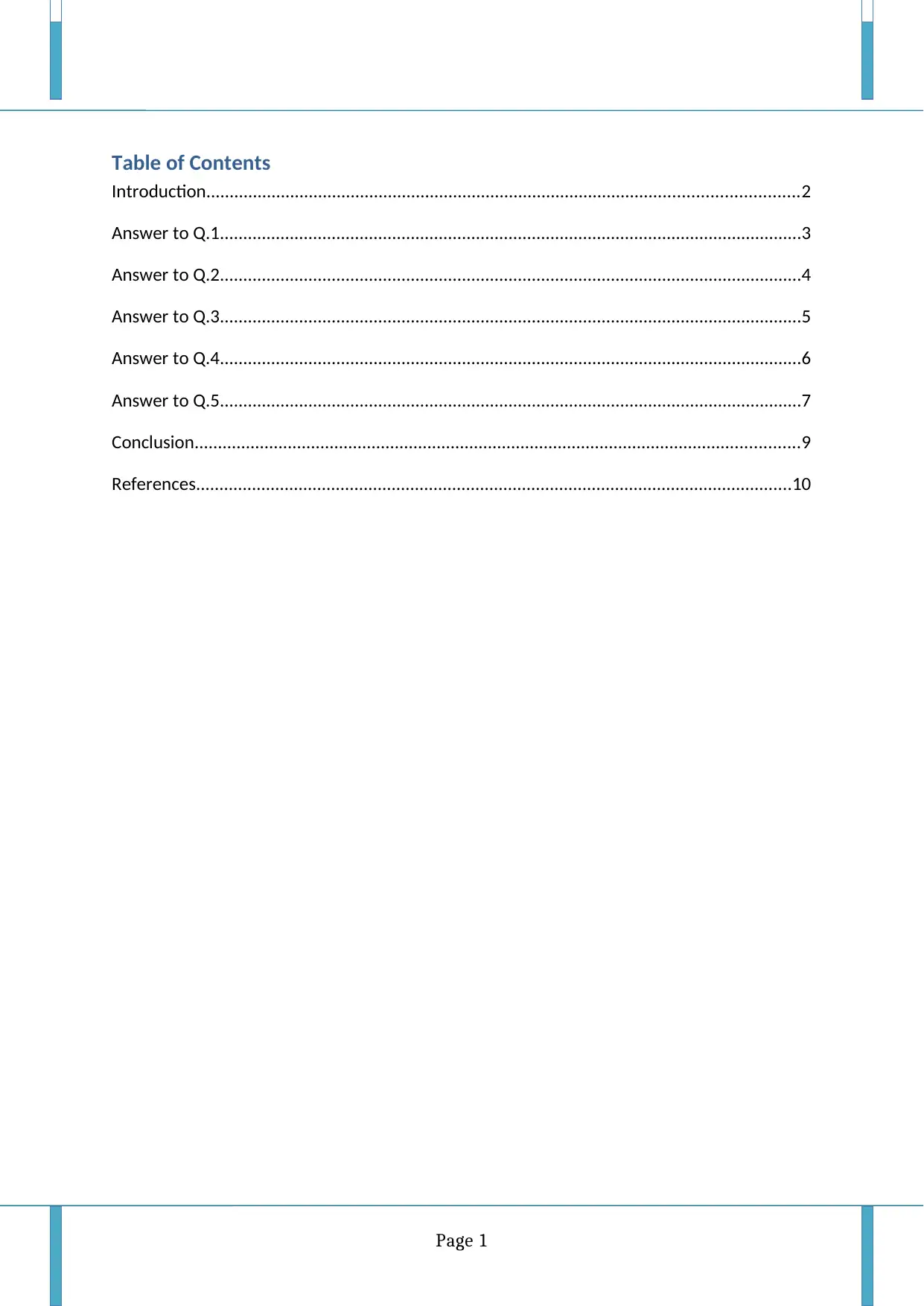
Table of Contents
Introduction...............................................................................................................................2
Answer to Q.1.............................................................................................................................3
Answer to Q.2.............................................................................................................................4
Answer to Q.3.............................................................................................................................5
Answer to Q.4.............................................................................................................................6
Answer to Q.5.............................................................................................................................7
Conclusion..................................................................................................................................9
References................................................................................................................................10
Page 1
Introduction...............................................................................................................................2
Answer to Q.1.............................................................................................................................3
Answer to Q.2.............................................................................................................................4
Answer to Q.3.............................................................................................................................5
Answer to Q.4.............................................................................................................................6
Answer to Q.5.............................................................................................................................7
Conclusion..................................................................................................................................9
References................................................................................................................................10
Page 1
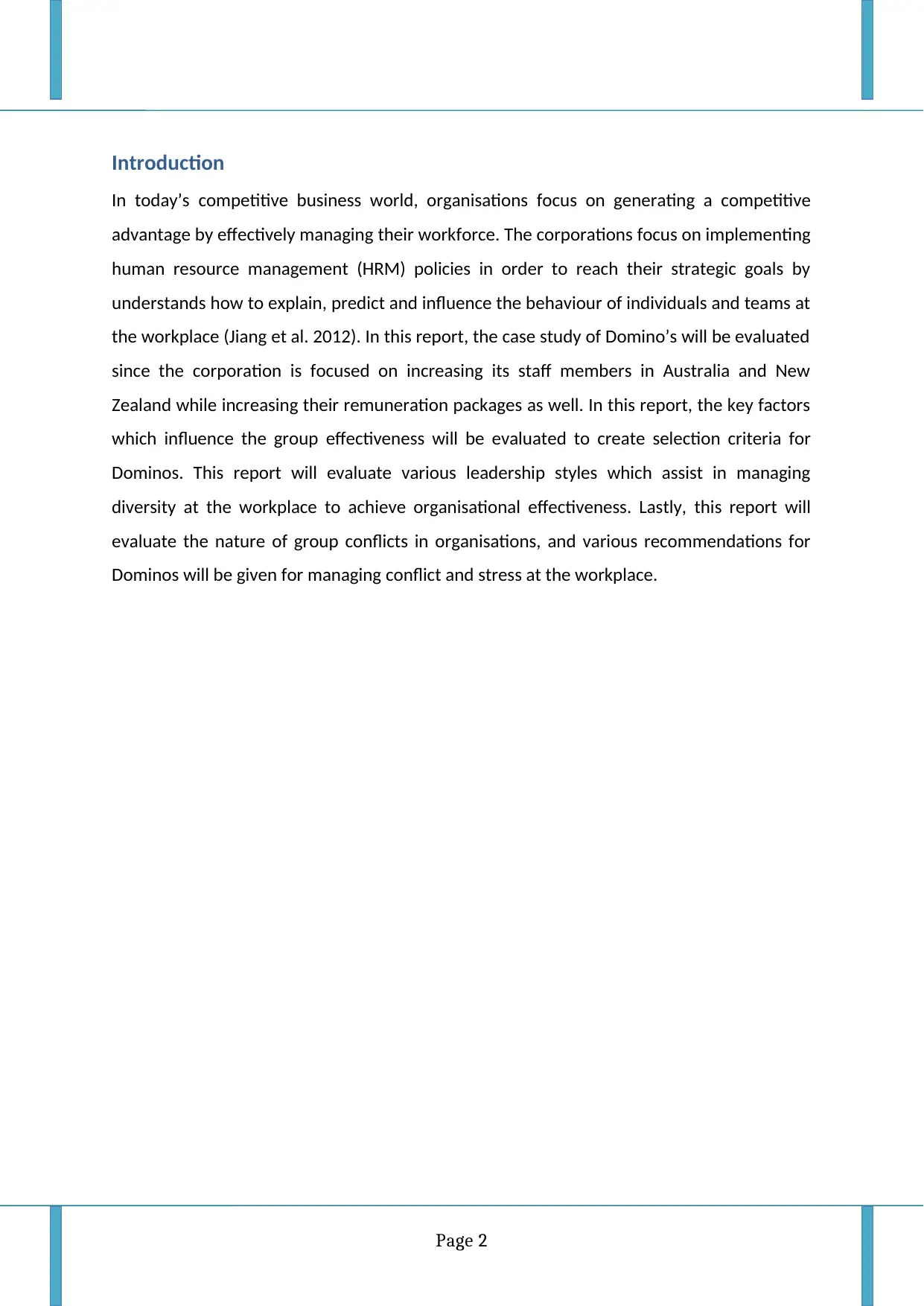
Introduction
In today’s competitive business world, organisations focus on generating a competitive
advantage by effectively managing their workforce. The corporations focus on implementing
human resource management (HRM) policies in order to reach their strategic goals by
understands how to explain, predict and influence the behaviour of individuals and teams at
the workplace (Jiang et al. 2012). In this report, the case study of Domino’s will be evaluated
since the corporation is focused on increasing its staff members in Australia and New
Zealand while increasing their remuneration packages as well. In this report, the key factors
which influence the group effectiveness will be evaluated to create selection criteria for
Dominos. This report will evaluate various leadership styles which assist in managing
diversity at the workplace to achieve organisational effectiveness. Lastly, this report will
evaluate the nature of group conflicts in organisations, and various recommendations for
Dominos will be given for managing conflict and stress at the workplace.
Page 2
In today’s competitive business world, organisations focus on generating a competitive
advantage by effectively managing their workforce. The corporations focus on implementing
human resource management (HRM) policies in order to reach their strategic goals by
understands how to explain, predict and influence the behaviour of individuals and teams at
the workplace (Jiang et al. 2012). In this report, the case study of Domino’s will be evaluated
since the corporation is focused on increasing its staff members in Australia and New
Zealand while increasing their remuneration packages as well. In this report, the key factors
which influence the group effectiveness will be evaluated to create selection criteria for
Dominos. This report will evaluate various leadership styles which assist in managing
diversity at the workplace to achieve organisational effectiveness. Lastly, this report will
evaluate the nature of group conflicts in organisations, and various recommendations for
Dominos will be given for managing conflict and stress at the workplace.
Page 2
⊘ This is a preview!⊘
Do you want full access?
Subscribe today to unlock all pages.

Trusted by 1+ million students worldwide
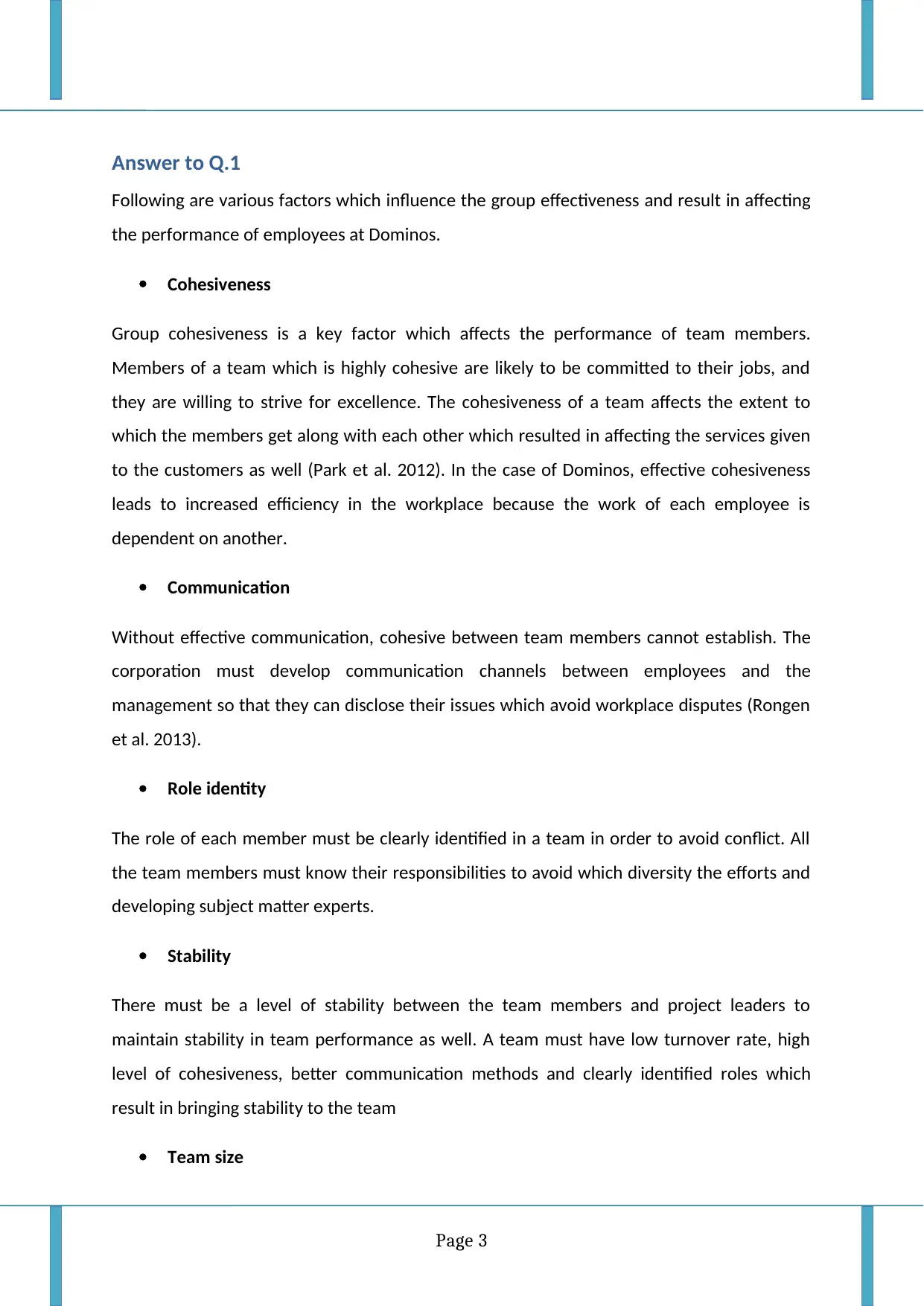
Answer to Q.1
Following are various factors which influence the group effectiveness and result in affecting
the performance of employees at Dominos.
Cohesiveness
Group cohesiveness is a key factor which affects the performance of team members.
Members of a team which is highly cohesive are likely to be committed to their jobs, and
they are willing to strive for excellence. The cohesiveness of a team affects the extent to
which the members get along with each other which resulted in affecting the services given
to the customers as well (Park et al. 2012). In the case of Dominos, effective cohesiveness
leads to increased efficiency in the workplace because the work of each employee is
dependent on another.
Communication
Without effective communication, cohesive between team members cannot establish. The
corporation must develop communication channels between employees and the
management so that they can disclose their issues which avoid workplace disputes (Rongen
et al. 2013).
Role identity
The role of each member must be clearly identified in a team in order to avoid conflict. All
the team members must know their responsibilities to avoid which diversity the efforts and
developing subject matter experts.
Stability
There must be a level of stability between the team members and project leaders to
maintain stability in team performance as well. A team must have low turnover rate, high
level of cohesiveness, better communication methods and clearly identified roles which
result in bringing stability to the team
Team size
Page 3
Following are various factors which influence the group effectiveness and result in affecting
the performance of employees at Dominos.
Cohesiveness
Group cohesiveness is a key factor which affects the performance of team members.
Members of a team which is highly cohesive are likely to be committed to their jobs, and
they are willing to strive for excellence. The cohesiveness of a team affects the extent to
which the members get along with each other which resulted in affecting the services given
to the customers as well (Park et al. 2012). In the case of Dominos, effective cohesiveness
leads to increased efficiency in the workplace because the work of each employee is
dependent on another.
Communication
Without effective communication, cohesive between team members cannot establish. The
corporation must develop communication channels between employees and the
management so that they can disclose their issues which avoid workplace disputes (Rongen
et al. 2013).
Role identity
The role of each member must be clearly identified in a team in order to avoid conflict. All
the team members must know their responsibilities to avoid which diversity the efforts and
developing subject matter experts.
Stability
There must be a level of stability between the team members and project leaders to
maintain stability in team performance as well. A team must have low turnover rate, high
level of cohesiveness, better communication methods and clearly identified roles which
result in bringing stability to the team
Team size
Page 3
Paraphrase This Document
Need a fresh take? Get an instant paraphrase of this document with our AI Paraphraser
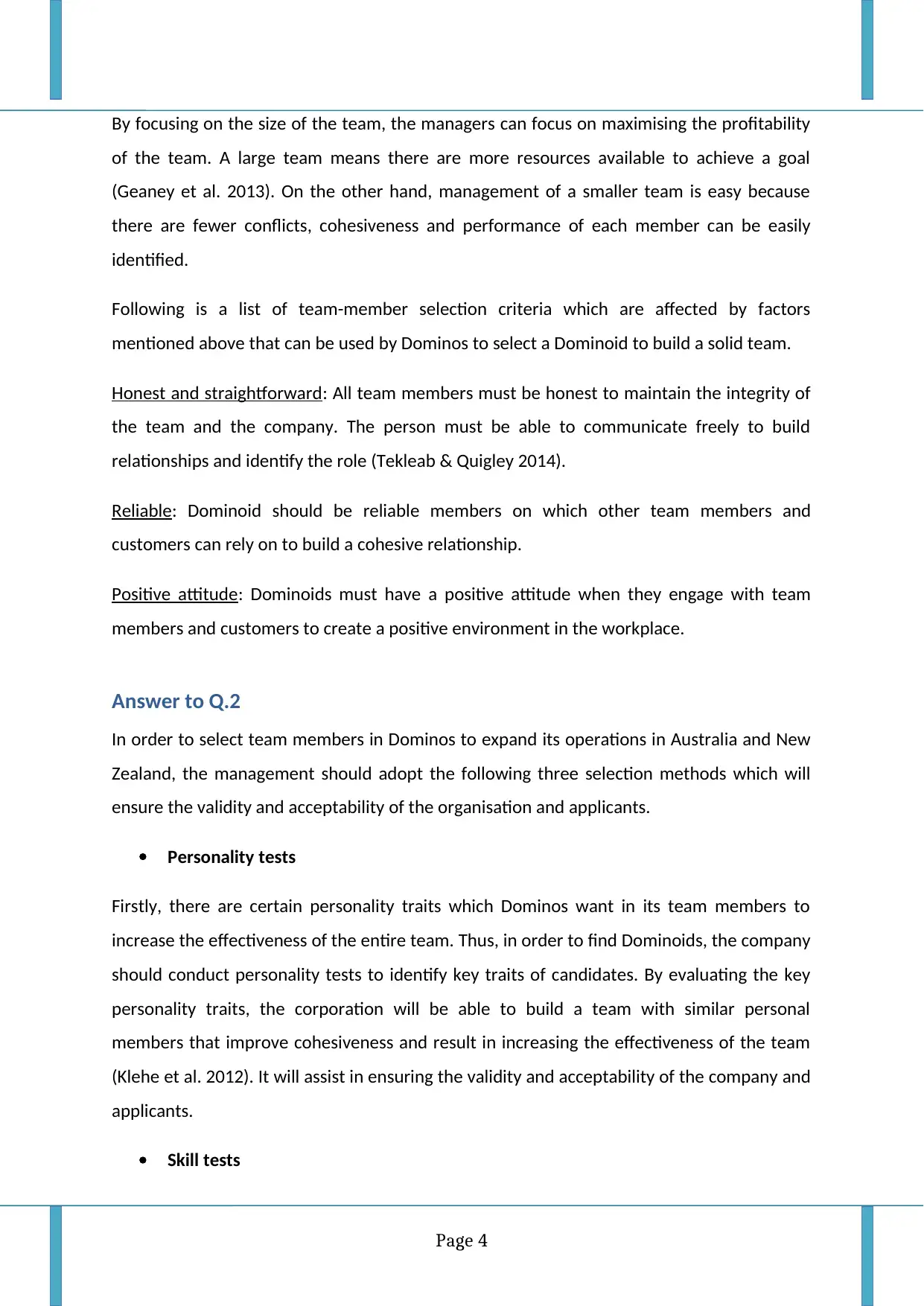
By focusing on the size of the team, the managers can focus on maximising the profitability
of the team. A large team means there are more resources available to achieve a goal
(Geaney et al. 2013). On the other hand, management of a smaller team is easy because
there are fewer conflicts, cohesiveness and performance of each member can be easily
identified.
Following is a list of team-member selection criteria which are affected by factors
mentioned above that can be used by Dominos to select a Dominoid to build a solid team.
Honest and straightforward: All team members must be honest to maintain the integrity of
the team and the company. The person must be able to communicate freely to build
relationships and identify the role (Tekleab & Quigley 2014).
Reliable: Dominoid should be reliable members on which other team members and
customers can rely on to build a cohesive relationship.
Positive attitude: Dominoids must have a positive attitude when they engage with team
members and customers to create a positive environment in the workplace.
Answer to Q.2
In order to select team members in Dominos to expand its operations in Australia and New
Zealand, the management should adopt the following three selection methods which will
ensure the validity and acceptability of the organisation and applicants.
Personality tests
Firstly, there are certain personality traits which Dominos want in its team members to
increase the effectiveness of the entire team. Thus, in order to find Dominoids, the company
should conduct personality tests to identify key traits of candidates. By evaluating the key
personality traits, the corporation will be able to build a team with similar personal
members that improve cohesiveness and result in increasing the effectiveness of the team
(Klehe et al. 2012). It will assist in ensuring the validity and acceptability of the company and
applicants.
Skill tests
Page 4
of the team. A large team means there are more resources available to achieve a goal
(Geaney et al. 2013). On the other hand, management of a smaller team is easy because
there are fewer conflicts, cohesiveness and performance of each member can be easily
identified.
Following is a list of team-member selection criteria which are affected by factors
mentioned above that can be used by Dominos to select a Dominoid to build a solid team.
Honest and straightforward: All team members must be honest to maintain the integrity of
the team and the company. The person must be able to communicate freely to build
relationships and identify the role (Tekleab & Quigley 2014).
Reliable: Dominoid should be reliable members on which other team members and
customers can rely on to build a cohesive relationship.
Positive attitude: Dominoids must have a positive attitude when they engage with team
members and customers to create a positive environment in the workplace.
Answer to Q.2
In order to select team members in Dominos to expand its operations in Australia and New
Zealand, the management should adopt the following three selection methods which will
ensure the validity and acceptability of the organisation and applicants.
Personality tests
Firstly, there are certain personality traits which Dominos want in its team members to
increase the effectiveness of the entire team. Thus, in order to find Dominoids, the company
should conduct personality tests to identify key traits of candidates. By evaluating the key
personality traits, the corporation will be able to build a team with similar personal
members that improve cohesiveness and result in increasing the effectiveness of the team
(Klehe et al. 2012). It will assist in ensuring the validity and acceptability of the company and
applicants.
Skill tests
Page 4
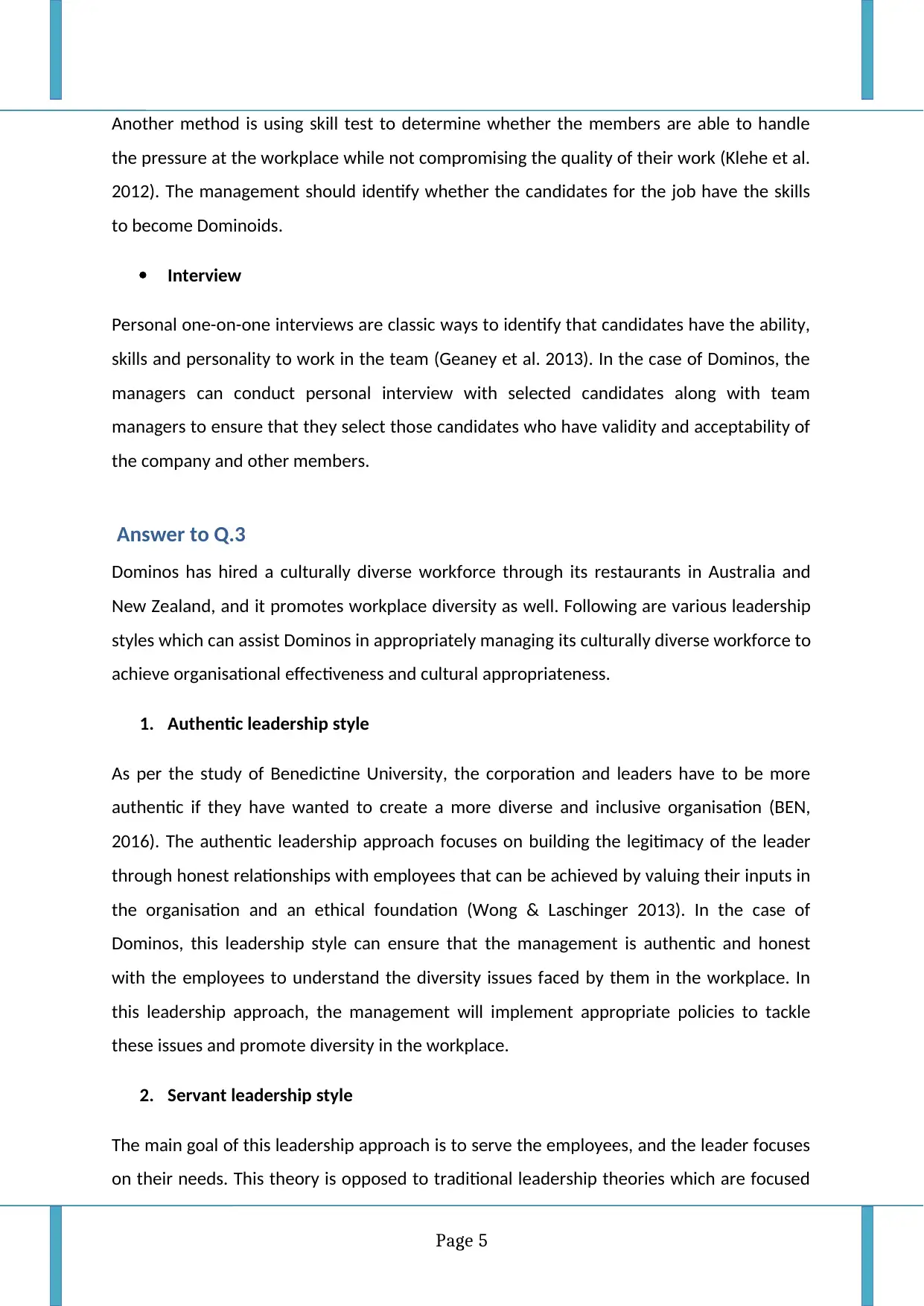
Another method is using skill test to determine whether the members are able to handle
the pressure at the workplace while not compromising the quality of their work (Klehe et al.
2012). The management should identify whether the candidates for the job have the skills
to become Dominoids.
Interview
Personal one-on-one interviews are classic ways to identify that candidates have the ability,
skills and personality to work in the team (Geaney et al. 2013). In the case of Dominos, the
managers can conduct personal interview with selected candidates along with team
managers to ensure that they select those candidates who have validity and acceptability of
the company and other members.
Answer to Q.3
Dominos has hired a culturally diverse workforce through its restaurants in Australia and
New Zealand, and it promotes workplace diversity as well. Following are various leadership
styles which can assist Dominos in appropriately managing its culturally diverse workforce to
achieve organisational effectiveness and cultural appropriateness.
1. Authentic leadership style
As per the study of Benedictine University, the corporation and leaders have to be more
authentic if they have wanted to create a more diverse and inclusive organisation (BEN,
2016). The authentic leadership approach focuses on building the legitimacy of the leader
through honest relationships with employees that can be achieved by valuing their inputs in
the organisation and an ethical foundation (Wong & Laschinger 2013). In the case of
Dominos, this leadership style can ensure that the management is authentic and honest
with the employees to understand the diversity issues faced by them in the workplace. In
this leadership approach, the management will implement appropriate policies to tackle
these issues and promote diversity in the workplace.
2. Servant leadership style
The main goal of this leadership approach is to serve the employees, and the leader focuses
on their needs. This theory is opposed to traditional leadership theories which are focused
Page 5
the pressure at the workplace while not compromising the quality of their work (Klehe et al.
2012). The management should identify whether the candidates for the job have the skills
to become Dominoids.
Interview
Personal one-on-one interviews are classic ways to identify that candidates have the ability,
skills and personality to work in the team (Geaney et al. 2013). In the case of Dominos, the
managers can conduct personal interview with selected candidates along with team
managers to ensure that they select those candidates who have validity and acceptability of
the company and other members.
Answer to Q.3
Dominos has hired a culturally diverse workforce through its restaurants in Australia and
New Zealand, and it promotes workplace diversity as well. Following are various leadership
styles which can assist Dominos in appropriately managing its culturally diverse workforce to
achieve organisational effectiveness and cultural appropriateness.
1. Authentic leadership style
As per the study of Benedictine University, the corporation and leaders have to be more
authentic if they have wanted to create a more diverse and inclusive organisation (BEN,
2016). The authentic leadership approach focuses on building the legitimacy of the leader
through honest relationships with employees that can be achieved by valuing their inputs in
the organisation and an ethical foundation (Wong & Laschinger 2013). In the case of
Dominos, this leadership style can ensure that the management is authentic and honest
with the employees to understand the diversity issues faced by them in the workplace. In
this leadership approach, the management will implement appropriate policies to tackle
these issues and promote diversity in the workplace.
2. Servant leadership style
The main goal of this leadership approach is to serve the employees, and the leader focuses
on their needs. This theory is opposed to traditional leadership theories which are focused
Page 5
⊘ This is a preview!⊘
Do you want full access?
Subscribe today to unlock all pages.

Trusted by 1+ million students worldwide
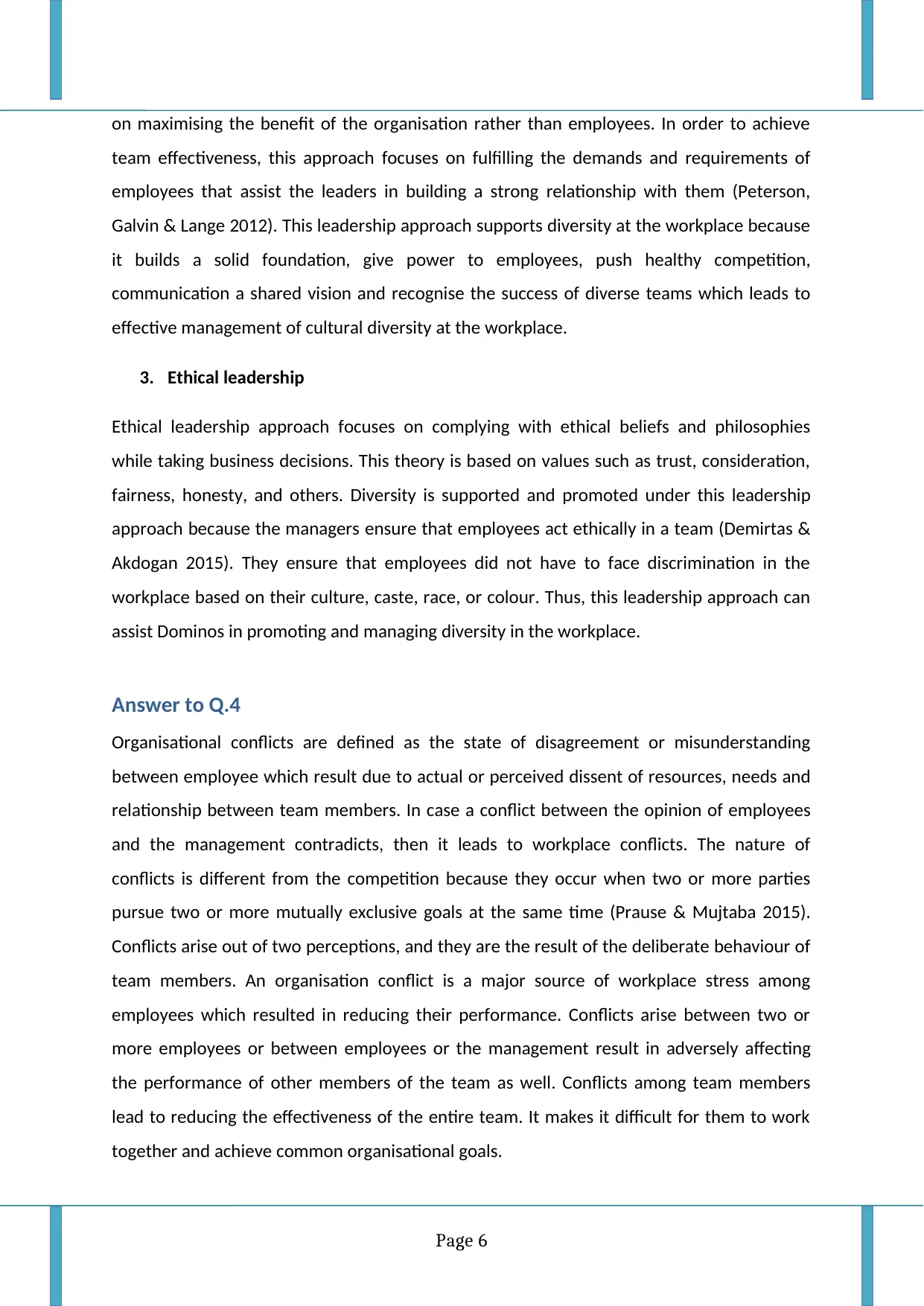
on maximising the benefit of the organisation rather than employees. In order to achieve
team effectiveness, this approach focuses on fulfilling the demands and requirements of
employees that assist the leaders in building a strong relationship with them (Peterson,
Galvin & Lange 2012). This leadership approach supports diversity at the workplace because
it builds a solid foundation, give power to employees, push healthy competition,
communication a shared vision and recognise the success of diverse teams which leads to
effective management of cultural diversity at the workplace.
3. Ethical leadership
Ethical leadership approach focuses on complying with ethical beliefs and philosophies
while taking business decisions. This theory is based on values such as trust, consideration,
fairness, honesty, and others. Diversity is supported and promoted under this leadership
approach because the managers ensure that employees act ethically in a team (Demirtas &
Akdogan 2015). They ensure that employees did not have to face discrimination in the
workplace based on their culture, caste, race, or colour. Thus, this leadership approach can
assist Dominos in promoting and managing diversity in the workplace.
Answer to Q.4
Organisational conflicts are defined as the state of disagreement or misunderstanding
between employee which result due to actual or perceived dissent of resources, needs and
relationship between team members. In case a conflict between the opinion of employees
and the management contradicts, then it leads to workplace conflicts. The nature of
conflicts is different from the competition because they occur when two or more parties
pursue two or more mutually exclusive goals at the same time (Prause & Mujtaba 2015).
Conflicts arise out of two perceptions, and they are the result of the deliberate behaviour of
team members. An organisation conflict is a major source of workplace stress among
employees which resulted in reducing their performance. Conflicts arise between two or
more employees or between employees or the management result in adversely affecting
the performance of other members of the team as well. Conflicts among team members
lead to reducing the effectiveness of the entire team. It makes it difficult for them to work
together and achieve common organisational goals.
Page 6
team effectiveness, this approach focuses on fulfilling the demands and requirements of
employees that assist the leaders in building a strong relationship with them (Peterson,
Galvin & Lange 2012). This leadership approach supports diversity at the workplace because
it builds a solid foundation, give power to employees, push healthy competition,
communication a shared vision and recognise the success of diverse teams which leads to
effective management of cultural diversity at the workplace.
3. Ethical leadership
Ethical leadership approach focuses on complying with ethical beliefs and philosophies
while taking business decisions. This theory is based on values such as trust, consideration,
fairness, honesty, and others. Diversity is supported and promoted under this leadership
approach because the managers ensure that employees act ethically in a team (Demirtas &
Akdogan 2015). They ensure that employees did not have to face discrimination in the
workplace based on their culture, caste, race, or colour. Thus, this leadership approach can
assist Dominos in promoting and managing diversity in the workplace.
Answer to Q.4
Organisational conflicts are defined as the state of disagreement or misunderstanding
between employee which result due to actual or perceived dissent of resources, needs and
relationship between team members. In case a conflict between the opinion of employees
and the management contradicts, then it leads to workplace conflicts. The nature of
conflicts is different from the competition because they occur when two or more parties
pursue two or more mutually exclusive goals at the same time (Prause & Mujtaba 2015).
Conflicts arise out of two perceptions, and they are the result of the deliberate behaviour of
team members. An organisation conflict is a major source of workplace stress among
employees which resulted in reducing their performance. Conflicts arise between two or
more employees or between employees or the management result in adversely affecting
the performance of other members of the team as well. Conflicts among team members
lead to reducing the effectiveness of the entire team. It makes it difficult for them to work
together and achieve common organisational goals.
Page 6
Paraphrase This Document
Need a fresh take? Get an instant paraphrase of this document with our AI Paraphraser
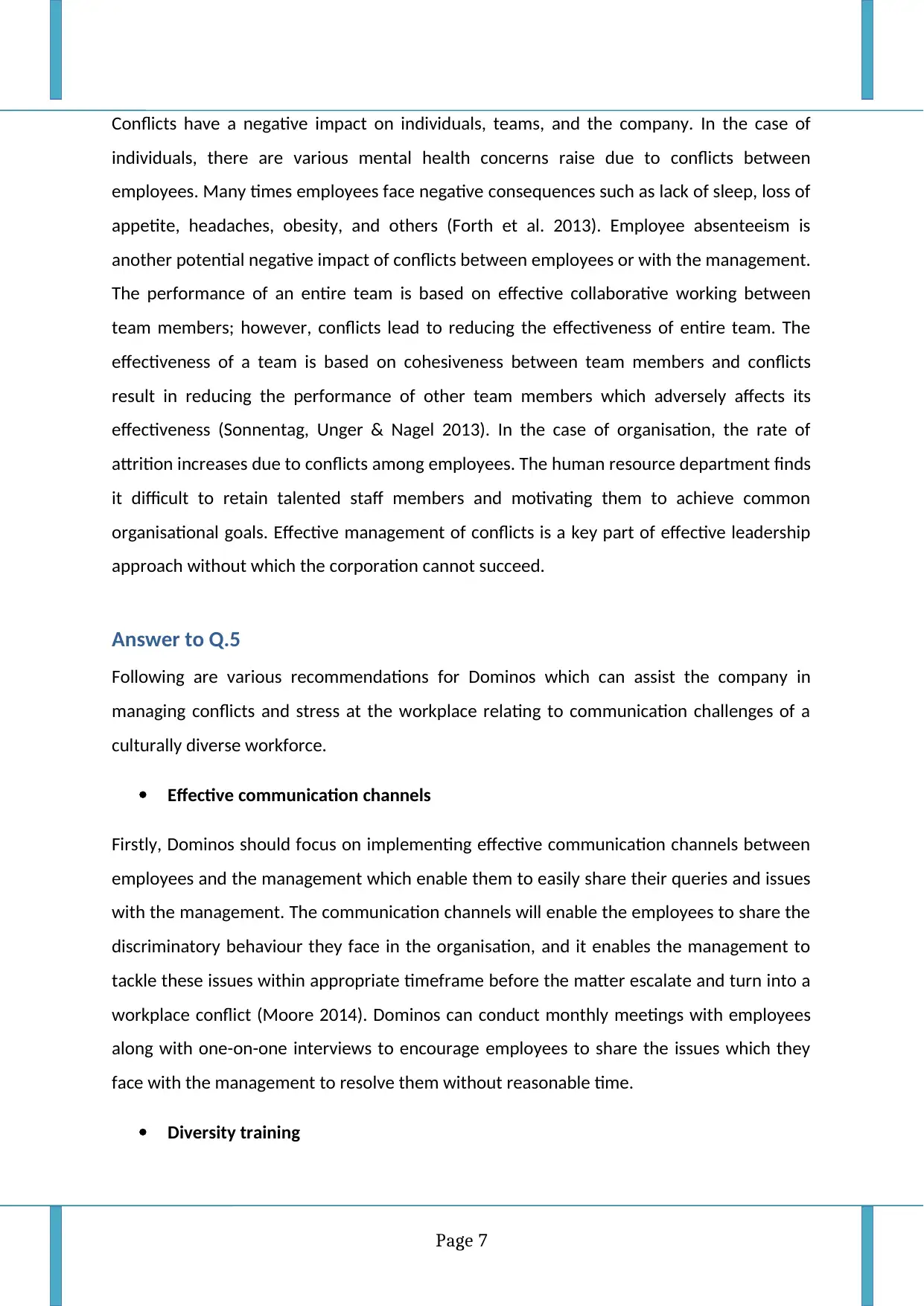
Conflicts have a negative impact on individuals, teams, and the company. In the case of
individuals, there are various mental health concerns raise due to conflicts between
employees. Many times employees face negative consequences such as lack of sleep, loss of
appetite, headaches, obesity, and others (Forth et al. 2013). Employee absenteeism is
another potential negative impact of conflicts between employees or with the management.
The performance of an entire team is based on effective collaborative working between
team members; however, conflicts lead to reducing the effectiveness of entire team. The
effectiveness of a team is based on cohesiveness between team members and conflicts
result in reducing the performance of other team members which adversely affects its
effectiveness (Sonnentag, Unger & Nagel 2013). In the case of organisation, the rate of
attrition increases due to conflicts among employees. The human resource department finds
it difficult to retain talented staff members and motivating them to achieve common
organisational goals. Effective management of conflicts is a key part of effective leadership
approach without which the corporation cannot succeed.
Answer to Q.5
Following are various recommendations for Dominos which can assist the company in
managing conflicts and stress at the workplace relating to communication challenges of a
culturally diverse workforce.
Effective communication channels
Firstly, Dominos should focus on implementing effective communication channels between
employees and the management which enable them to easily share their queries and issues
with the management. The communication channels will enable the employees to share the
discriminatory behaviour they face in the organisation, and it enables the management to
tackle these issues within appropriate timeframe before the matter escalate and turn into a
workplace conflict (Moore 2014). Dominos can conduct monthly meetings with employees
along with one-on-one interviews to encourage employees to share the issues which they
face with the management to resolve them without reasonable time.
Diversity training
Page 7
individuals, there are various mental health concerns raise due to conflicts between
employees. Many times employees face negative consequences such as lack of sleep, loss of
appetite, headaches, obesity, and others (Forth et al. 2013). Employee absenteeism is
another potential negative impact of conflicts between employees or with the management.
The performance of an entire team is based on effective collaborative working between
team members; however, conflicts lead to reducing the effectiveness of entire team. The
effectiveness of a team is based on cohesiveness between team members and conflicts
result in reducing the performance of other team members which adversely affects its
effectiveness (Sonnentag, Unger & Nagel 2013). In the case of organisation, the rate of
attrition increases due to conflicts among employees. The human resource department finds
it difficult to retain talented staff members and motivating them to achieve common
organisational goals. Effective management of conflicts is a key part of effective leadership
approach without which the corporation cannot succeed.
Answer to Q.5
Following are various recommendations for Dominos which can assist the company in
managing conflicts and stress at the workplace relating to communication challenges of a
culturally diverse workforce.
Effective communication channels
Firstly, Dominos should focus on implementing effective communication channels between
employees and the management which enable them to easily share their queries and issues
with the management. The communication channels will enable the employees to share the
discriminatory behaviour they face in the organisation, and it enables the management to
tackle these issues within appropriate timeframe before the matter escalate and turn into a
workplace conflict (Moore 2014). Dominos can conduct monthly meetings with employees
along with one-on-one interviews to encourage employees to share the issues which they
face with the management to resolve them without reasonable time.
Diversity training
Page 7
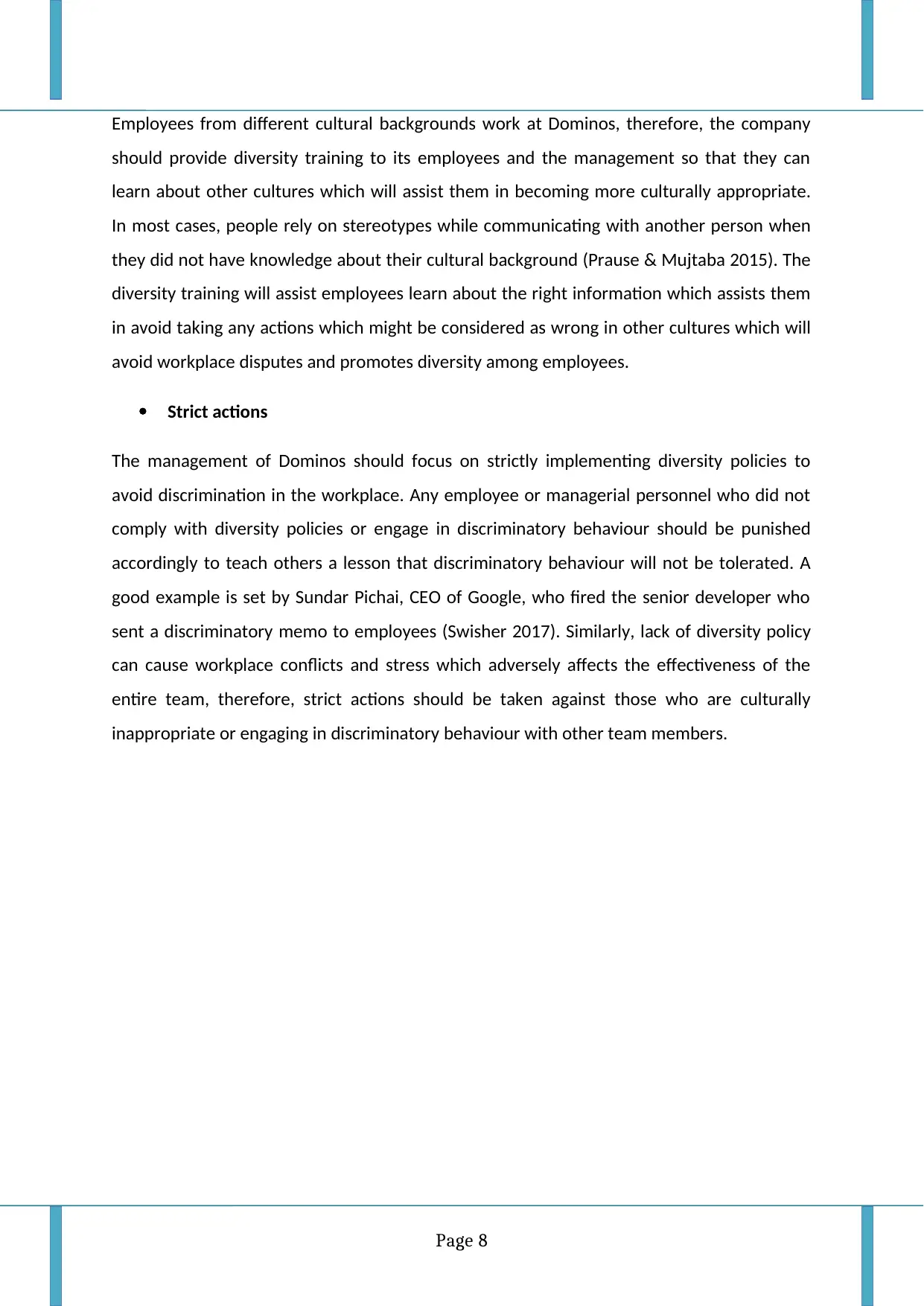
Employees from different cultural backgrounds work at Dominos, therefore, the company
should provide diversity training to its employees and the management so that they can
learn about other cultures which will assist them in becoming more culturally appropriate.
In most cases, people rely on stereotypes while communicating with another person when
they did not have knowledge about their cultural background (Prause & Mujtaba 2015). The
diversity training will assist employees learn about the right information which assists them
in avoid taking any actions which might be considered as wrong in other cultures which will
avoid workplace disputes and promotes diversity among employees.
Strict actions
The management of Dominos should focus on strictly implementing diversity policies to
avoid discrimination in the workplace. Any employee or managerial personnel who did not
comply with diversity policies or engage in discriminatory behaviour should be punished
accordingly to teach others a lesson that discriminatory behaviour will not be tolerated. A
good example is set by Sundar Pichai, CEO of Google, who fired the senior developer who
sent a discriminatory memo to employees (Swisher 2017). Similarly, lack of diversity policy
can cause workplace conflicts and stress which adversely affects the effectiveness of the
entire team, therefore, strict actions should be taken against those who are culturally
inappropriate or engaging in discriminatory behaviour with other team members.
Page 8
should provide diversity training to its employees and the management so that they can
learn about other cultures which will assist them in becoming more culturally appropriate.
In most cases, people rely on stereotypes while communicating with another person when
they did not have knowledge about their cultural background (Prause & Mujtaba 2015). The
diversity training will assist employees learn about the right information which assists them
in avoid taking any actions which might be considered as wrong in other cultures which will
avoid workplace disputes and promotes diversity among employees.
Strict actions
The management of Dominos should focus on strictly implementing diversity policies to
avoid discrimination in the workplace. Any employee or managerial personnel who did not
comply with diversity policies or engage in discriminatory behaviour should be punished
accordingly to teach others a lesson that discriminatory behaviour will not be tolerated. A
good example is set by Sundar Pichai, CEO of Google, who fired the senior developer who
sent a discriminatory memo to employees (Swisher 2017). Similarly, lack of diversity policy
can cause workplace conflicts and stress which adversely affects the effectiveness of the
entire team, therefore, strict actions should be taken against those who are culturally
inappropriate or engaging in discriminatory behaviour with other team members.
Page 8
⊘ This is a preview!⊘
Do you want full access?
Subscribe today to unlock all pages.

Trusted by 1+ million students worldwide
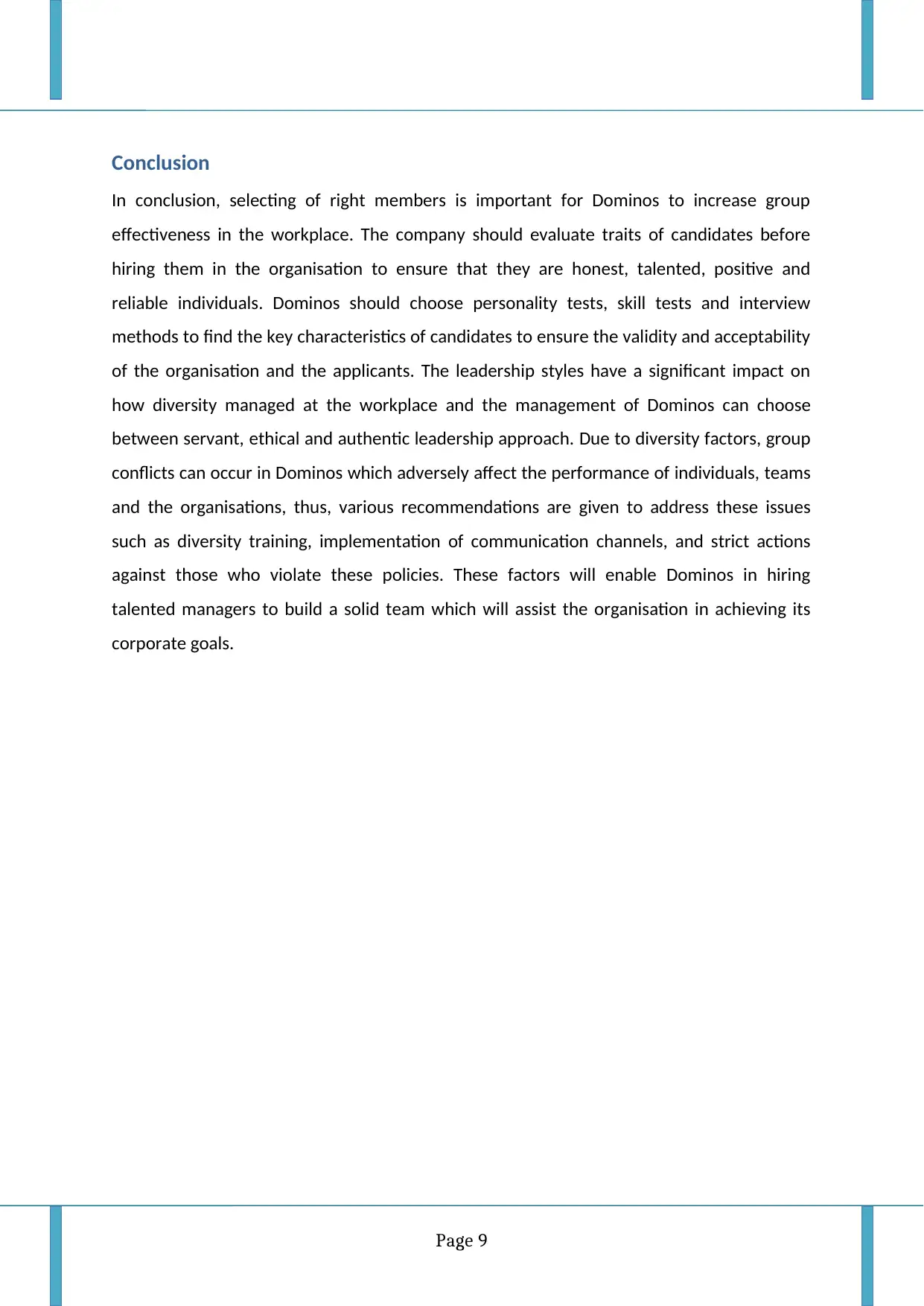
Conclusion
In conclusion, selecting of right members is important for Dominos to increase group
effectiveness in the workplace. The company should evaluate traits of candidates before
hiring them in the organisation to ensure that they are honest, talented, positive and
reliable individuals. Dominos should choose personality tests, skill tests and interview
methods to find the key characteristics of candidates to ensure the validity and acceptability
of the organisation and the applicants. The leadership styles have a significant impact on
how diversity managed at the workplace and the management of Dominos can choose
between servant, ethical and authentic leadership approach. Due to diversity factors, group
conflicts can occur in Dominos which adversely affect the performance of individuals, teams
and the organisations, thus, various recommendations are given to address these issues
such as diversity training, implementation of communication channels, and strict actions
against those who violate these policies. These factors will enable Dominos in hiring
talented managers to build a solid team which will assist the organisation in achieving its
corporate goals.
Page 9
In conclusion, selecting of right members is important for Dominos to increase group
effectiveness in the workplace. The company should evaluate traits of candidates before
hiring them in the organisation to ensure that they are honest, talented, positive and
reliable individuals. Dominos should choose personality tests, skill tests and interview
methods to find the key characteristics of candidates to ensure the validity and acceptability
of the organisation and the applicants. The leadership styles have a significant impact on
how diversity managed at the workplace and the management of Dominos can choose
between servant, ethical and authentic leadership approach. Due to diversity factors, group
conflicts can occur in Dominos which adversely affect the performance of individuals, teams
and the organisations, thus, various recommendations are given to address these issues
such as diversity training, implementation of communication channels, and strict actions
against those who violate these policies. These factors will enable Dominos in hiring
talented managers to build a solid team which will assist the organisation in achieving its
corporate goals.
Page 9
Paraphrase This Document
Need a fresh take? Get an instant paraphrase of this document with our AI Paraphraser
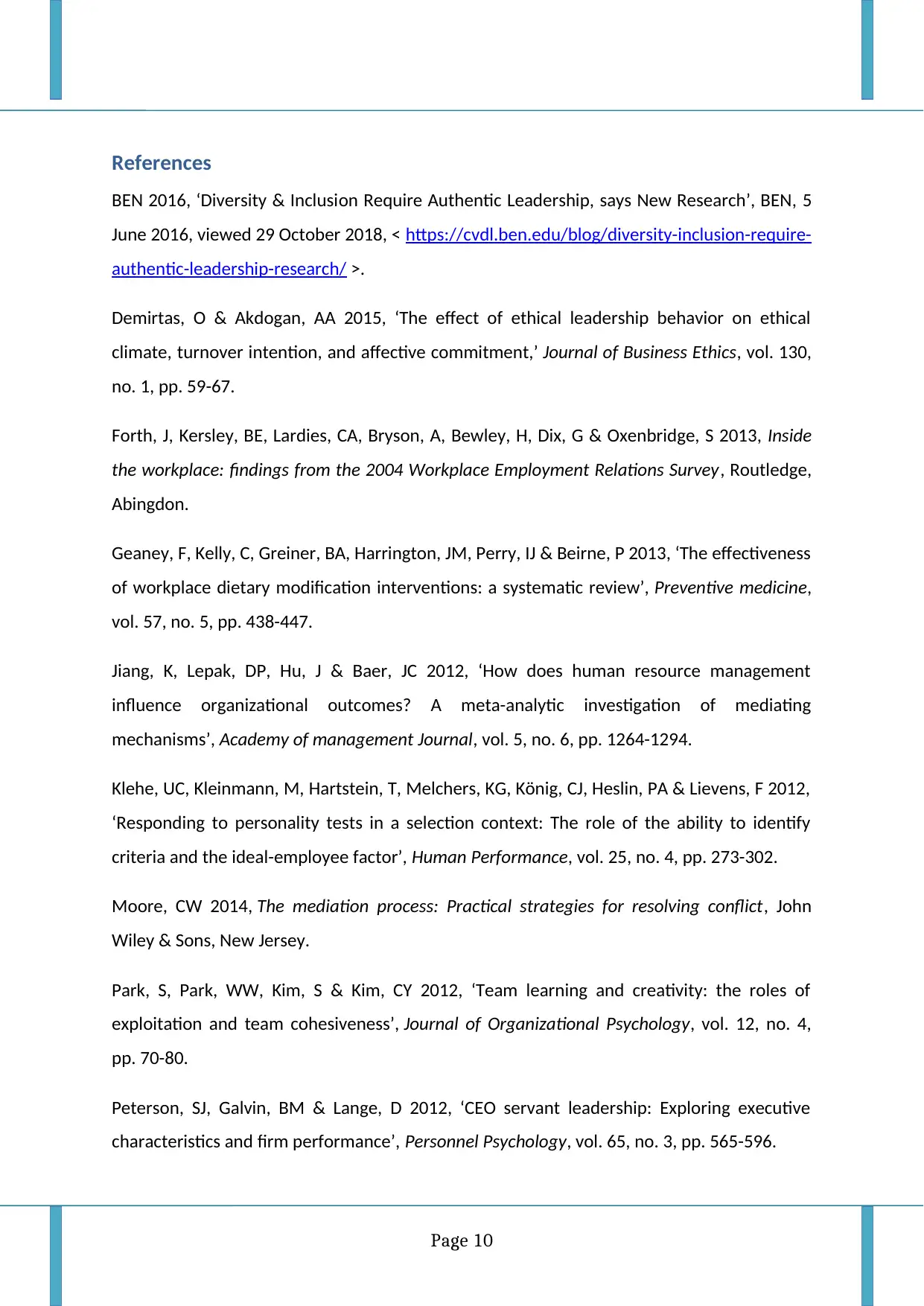
References
BEN 2016, ‘Diversity & Inclusion Require Authentic Leadership, says New Research’, BEN, 5
June 2016, viewed 29 October 2018, < https://cvdl.ben.edu/blog/diversity-inclusion-require-
authentic-leadership-research/ >.
Demirtas, O & Akdogan, AA 2015, ‘The effect of ethical leadership behavior on ethical
climate, turnover intention, and affective commitment,’ Journal of Business Ethics, vol. 130,
no. 1, pp. 59-67.
Forth, J, Kersley, BE, Lardies, CA, Bryson, A, Bewley, H, Dix, G & Oxenbridge, S 2013, Inside
the workplace: findings from the 2004 Workplace Employment Relations Survey, Routledge,
Abingdon.
Geaney, F, Kelly, C, Greiner, BA, Harrington, JM, Perry, IJ & Beirne, P 2013, ‘The effectiveness
of workplace dietary modification interventions: a systematic review’, Preventive medicine,
vol. 57, no. 5, pp. 438-447.
Jiang, K, Lepak, DP, Hu, J & Baer, JC 2012, ‘How does human resource management
influence organizational outcomes? A meta-analytic investigation of mediating
mechanisms’, Academy of management Journal, vol. 5, no. 6, pp. 1264-1294.
Klehe, UC, Kleinmann, M, Hartstein, T, Melchers, KG, König, CJ, Heslin, PA & Lievens, F 2012,
‘Responding to personality tests in a selection context: The role of the ability to identify
criteria and the ideal-employee factor’, Human Performance, vol. 25, no. 4, pp. 273-302.
Moore, CW 2014, The mediation process: Practical strategies for resolving conflict, John
Wiley & Sons, New Jersey.
Park, S, Park, WW, Kim, S & Kim, CY 2012, ‘Team learning and creativity: the roles of
exploitation and team cohesiveness’, Journal of Organizational Psychology, vol. 12, no. 4,
pp. 70-80.
Peterson, SJ, Galvin, BM & Lange, D 2012, ‘CEO servant leadership: Exploring executive
characteristics and firm performance’, Personnel Psychology, vol. 65, no. 3, pp. 565-596.
Page 10
BEN 2016, ‘Diversity & Inclusion Require Authentic Leadership, says New Research’, BEN, 5
June 2016, viewed 29 October 2018, < https://cvdl.ben.edu/blog/diversity-inclusion-require-
authentic-leadership-research/ >.
Demirtas, O & Akdogan, AA 2015, ‘The effect of ethical leadership behavior on ethical
climate, turnover intention, and affective commitment,’ Journal of Business Ethics, vol. 130,
no. 1, pp. 59-67.
Forth, J, Kersley, BE, Lardies, CA, Bryson, A, Bewley, H, Dix, G & Oxenbridge, S 2013, Inside
the workplace: findings from the 2004 Workplace Employment Relations Survey, Routledge,
Abingdon.
Geaney, F, Kelly, C, Greiner, BA, Harrington, JM, Perry, IJ & Beirne, P 2013, ‘The effectiveness
of workplace dietary modification interventions: a systematic review’, Preventive medicine,
vol. 57, no. 5, pp. 438-447.
Jiang, K, Lepak, DP, Hu, J & Baer, JC 2012, ‘How does human resource management
influence organizational outcomes? A meta-analytic investigation of mediating
mechanisms’, Academy of management Journal, vol. 5, no. 6, pp. 1264-1294.
Klehe, UC, Kleinmann, M, Hartstein, T, Melchers, KG, König, CJ, Heslin, PA & Lievens, F 2012,
‘Responding to personality tests in a selection context: The role of the ability to identify
criteria and the ideal-employee factor’, Human Performance, vol. 25, no. 4, pp. 273-302.
Moore, CW 2014, The mediation process: Practical strategies for resolving conflict, John
Wiley & Sons, New Jersey.
Park, S, Park, WW, Kim, S & Kim, CY 2012, ‘Team learning and creativity: the roles of
exploitation and team cohesiveness’, Journal of Organizational Psychology, vol. 12, no. 4,
pp. 70-80.
Peterson, SJ, Galvin, BM & Lange, D 2012, ‘CEO servant leadership: Exploring executive
characteristics and firm performance’, Personnel Psychology, vol. 65, no. 3, pp. 565-596.
Page 10
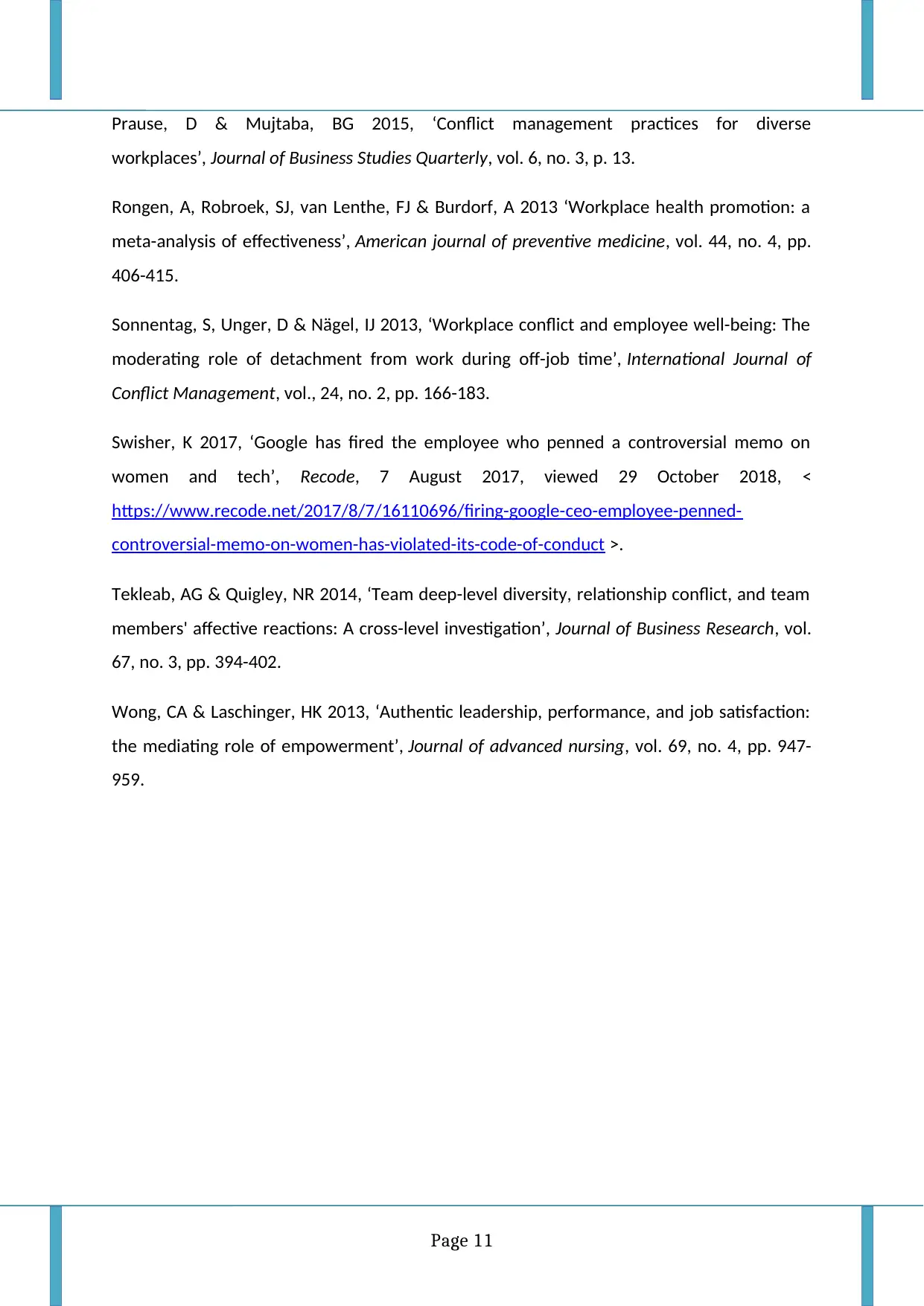
Prause, D & Mujtaba, BG 2015, ‘Conflict management practices for diverse
workplaces’, Journal of Business Studies Quarterly, vol. 6, no. 3, p. 13.
Rongen, A, Robroek, SJ, van Lenthe, FJ & Burdorf, A 2013 ‘Workplace health promotion: a
meta-analysis of effectiveness’, American journal of preventive medicine, vol. 44, no. 4, pp.
406-415.
Sonnentag, S, Unger, D & Nägel, IJ 2013, ‘Workplace conflict and employee well-being: The
moderating role of detachment from work during off-job time’, International Journal of
Conflict Management, vol., 24, no. 2, pp. 166-183.
Swisher, K 2017, ‘Google has fired the employee who penned a controversial memo on
women and tech’, Recode, 7 August 2017, viewed 29 October 2018, <
https://www.recode.net/2017/8/7/16110696/firing-google-ceo-employee-penned-
controversial-memo-on-women-has-violated-its-code-of-conduct >.
Tekleab, AG & Quigley, NR 2014, ‘Team deep-level diversity, relationship conflict, and team
members' affective reactions: A cross-level investigation’, Journal of Business Research, vol.
67, no. 3, pp. 394-402.
Wong, CA & Laschinger, HK 2013, ‘Authentic leadership, performance, and job satisfaction:
the mediating role of empowerment’, Journal of advanced nursing, vol. 69, no. 4, pp. 947-
959.
Page 11
workplaces’, Journal of Business Studies Quarterly, vol. 6, no. 3, p. 13.
Rongen, A, Robroek, SJ, van Lenthe, FJ & Burdorf, A 2013 ‘Workplace health promotion: a
meta-analysis of effectiveness’, American journal of preventive medicine, vol. 44, no. 4, pp.
406-415.
Sonnentag, S, Unger, D & Nägel, IJ 2013, ‘Workplace conflict and employee well-being: The
moderating role of detachment from work during off-job time’, International Journal of
Conflict Management, vol., 24, no. 2, pp. 166-183.
Swisher, K 2017, ‘Google has fired the employee who penned a controversial memo on
women and tech’, Recode, 7 August 2017, viewed 29 October 2018, <
https://www.recode.net/2017/8/7/16110696/firing-google-ceo-employee-penned-
controversial-memo-on-women-has-violated-its-code-of-conduct >.
Tekleab, AG & Quigley, NR 2014, ‘Team deep-level diversity, relationship conflict, and team
members' affective reactions: A cross-level investigation’, Journal of Business Research, vol.
67, no. 3, pp. 394-402.
Wong, CA & Laschinger, HK 2013, ‘Authentic leadership, performance, and job satisfaction:
the mediating role of empowerment’, Journal of advanced nursing, vol. 69, no. 4, pp. 947-
959.
Page 11
⊘ This is a preview!⊘
Do you want full access?
Subscribe today to unlock all pages.

Trusted by 1+ million students worldwide
1 out of 12
Related Documents
Your All-in-One AI-Powered Toolkit for Academic Success.
+13062052269
info@desklib.com
Available 24*7 on WhatsApp / Email
![[object Object]](/_next/static/media/star-bottom.7253800d.svg)
Unlock your academic potential
Copyright © 2020–2025 A2Z Services. All Rights Reserved. Developed and managed by ZUCOL.




